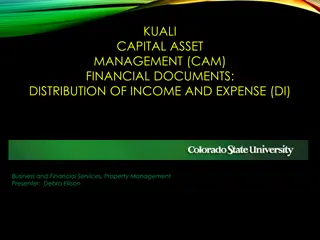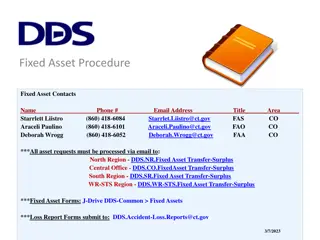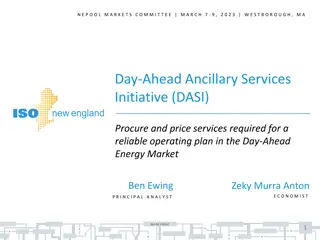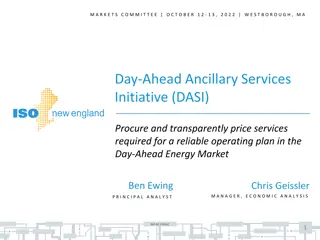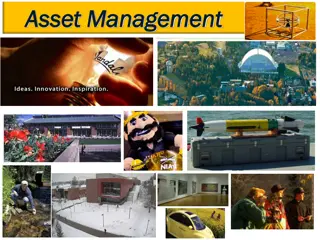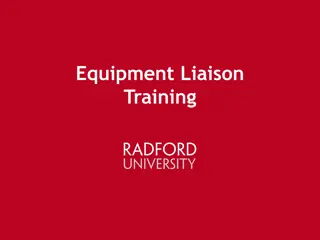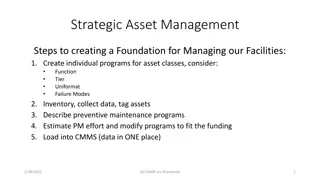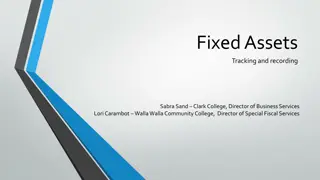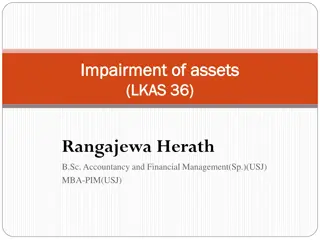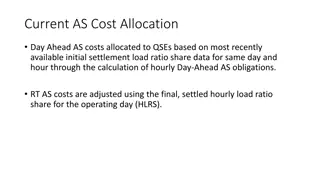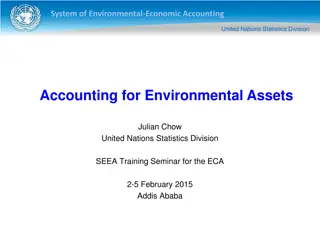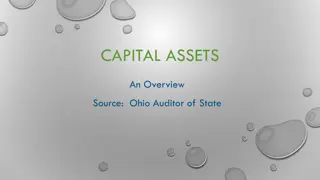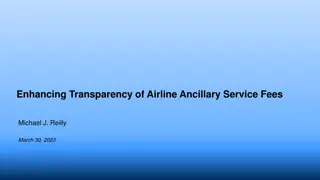Transportation Asset Management for Ancillary Assets Overview
This project focuses on asset management for ancillary assets in transportation, providing information on classification hierarchy, life cycle management, state-of-the-practice, and recommended business processes. Tasks include project kickoff, developing hierarchy, documenting practices, identifying best practices, and preparing a final report.
Download Presentation

Please find below an Image/Link to download the presentation.
The content on the website is provided AS IS for your information and personal use only. It may not be sold, licensed, or shared on other websites without obtaining consent from the author. Download presentation by click this link. If you encounter any issues during the download, it is possible that the publisher has removed the file from their server.
E N D
Presentation Transcript
NCHRP 08-36 TASK 114 Transportation Asset Management for Ancillary Assets Primary Authors: David Rose, Ph.D. Keyur Shah John Patrick O Har, Ph.D. Parsons Brinckerhoff
Overview Project Approach Project Tasks Asset Classification Hierarchy Assets Selected for Focus State-of-the-Practice Life Cycle Management Principles Integrating Ancillary Assets into Enterprise Asset Management Systems Results Sample guidance template for High Mast Light Poles Next steps 2 | Transportation Asset Management for Ancillary Assets
Project Approach Provide information to serve as a starting point to approach asset management for ancillary assets Classification hierarchy for ancillary assets Identification of how the life cycle management of ancillary assets can be incorporated into enterprise asset management systems State-of-the-practice for asset management of a subset of ancillary assets Recommended life cycle management business processes for the subset of ancillary assets 3 | Transportation Asset Management for Ancillary Assets
Project Tasks Task 1: Project Kickoff Meet with project panel Task 2: Develop Classification Hierarchy for Ancillary Assets Review prior NCHRP studies Assess prior frameworks and develop standard hierarchy Task 3: Document Ancillary Asset Lifecycle Management Practices Select volunteer DOTs for surveys Analyze state of practice Task 4: Identify Best Practices Use survey results, prior research, and the team's knowledge to identify best practices Task 5: Final Report Compare best practices and state-of-the-practice Identify linkages with asset management systems Analyze results of survey 4 | Transportation Asset Management for Ancillary Assets
Asset Classification Hierarchy Asset Class Asset Elements Asset Sub-Elements (if Applicable) Drainage Structures Overhead Sign and Signal Structures Retaining walls (Earth retaining structures) Structures (not bridges or otherwise in the national bridge inventory) Noise barriers High Mast Light Poles Signals, beacons, flashers, ramp meters Signals Cameras, variable message signs, detection devices/sensors, highway advisory radios Traffic Control & Management Active Devices ITS Equipment Hubs and nodes, fiber, cabinets, software Network Backbone 5 | Transportation Asset Management for Ancillary Assets
Asset Classification Hierarchy Continued Asset Class Asset Elements Asset Sub-Elements (if Applicable) Regulatory and warning signs Guide, service and attraction signs Guardrails, barrier walls, cable barriers, end treatments, impact attenuators Drains, drop inlets, catch basins, gutters Signs Traffic Control & Management Passive Control Devices Barrier Systems Drain Inlets and Outlets Culverts (< 20 ft)/Pipes Paved and unpaved ditches Drainage Systems and Environmental Mitigation Features Ditches Environmental Mitigation Features (Storm Water Retention Systems) Other Drains Slotted drains Other Safety Features Lighting Sidewalks Roadside Features ADA ramps Curbs 6 | Transportation Asset Management for Ancillary Assets
Ancillary Assets Selected for Further Focus Culverts (<20 ft.)/Pipes Drainage Systems and Environmental Mitigation Features Drain Inlets/Outlets; Ditches; Storm Water Retention Systems; Other Drains Overhead Sign and Signal Structures High Mast Light Poles ITS Equipment Cameras; Variable Message Signs; Detection Sensors/Devices; Highway Advisory Radios Network Backbone Hubs and Nodes; Fiber; Cabinets; Software Sidewalks and Curbs 7 | Transportation Asset Management for Ancillary Assets
State-of-the-Practice Internationally-accepted standards for the management of physical infrastructure assets (ISO 55000 and PAS 55) Considerable body of knowledge related to the management of pavements and bridges in the U.S. Passage of MAP-21 resulted in new asset management requirements primarily focused on pavement and bridge assets Much of the literature on ancillary asset management captures state-of-the-practice Generally no industry standards for the management of ancillary roadway assets 8 | Transportation Asset Management for Ancillary Assets
Life Cycle Management Principles Project team used the terminology and elements of asset management as outlined in PAS 55 and ISO 55000 Management system (ISO 55000): a set of interrelated or interacting elements of an organization to establish policies and objectives, and processes to achieve those objectives Asset management information (PAS 55): meaningful data related to assets and asset management Asset management information system (PAS 55): a system for the storage, processing, and transmission of asset management information 9 | Transportation Asset Management for Ancillary Assets
Key Elements for Asset Management 10 | Transportation Asset Management for Ancillary Assets
Asset Life Cycle Stages and Key Decision Points 11 | Transportation Asset Management for Ancillary Assets
Integrating Ancillary Assets into Enterprise Asset Management Systems 12 | Transportation Asset Management for Ancillary Assets
Template for Life Cycle Management Business Process Guidance Enterprise-level Inventory Interaction between Asset Classes Relationship of Asset Class to Overall Safety, Mobility, and Asset Performance Asset Specific-level Inspection and Condition Assessment Level of Service/Performance Metrics Lifecycle Management Plans and Practices Asset Prioritization Decision Support Additional Sections Asset Element-specific Considerations Additional References 13 | Transportation Asset Management for Ancillary Assets
Sample Template High Mast Light Poles Asset Element-specific Considerations Provide proven improvement to nighttime driving conditions Height presents challenge for inspections Enterprise-level Inventory Recommended complete inventory with basic data items including location, condition, and age Interaction between Asset Classes Failure can result in closure of crucial links in the highway system Relationship of Asset Class to Overall Safety, Mobility, and Asset Performance Provide illumination that can improve safety 14 | Transportation Asset Management for Ancillary Assets
High Mast Light Pole Template Asset Specific-level Inspection and Condition Assessment Visual inspections with binoculars or telescopes Remotely-operated inspection devices with video cameras NDT techniques to inspect base plates and anchor rods Inspect at least every 4 to 5 years potentially greater frequency for anchor bolts which are known to loosen over time Level of Service/Performance Metrics Typically simple condition rating scale comparing current performance against originally intended function Lifecycle Management Plans and Practices Track maintenance activities and forecast future activities such as anchor bolt tightening, repair, or replacement Account for need to replace lamps Asset Prioritization After high-wind weather events prioritize inspections Prioritize inspections in areas with known nighttime safety issues Decision Support Track maintenance costs to inform future needs estimates Estimate remaining service life based on installation date and age 15 | Transportation Asset Management for Ancillary Assets
High Mast Light Pole Template Continued Additional References Garlich, M.J. & Thorkildsen, E.T., 2005. Guidelines for the Installation, Inspection, Maintenance and Repair of Structural Supports for Highway Signs, Luminaries, and Traffic Signals, Washington, D.C. Sheth, P.N. & Montie, D., 2005. Integrated Light Maintenance and Inspection System for High-Mast Poles, Charlottesville, VA. Goyal, R., Dhonde, H.B. & Dawood, M., 2012. Fatigue Failure and Cracking in High Mast Poles, Houston, Texas. 16 | Transportation Asset Management for Ancillary Assets
Next Steps Results of this research provide a foundation to develop TAMPs for a subset of ancillary assets Further research needed to developed generally accepted standards for the management of ancillary assets, particularly for: Culverts Drainage Systems and Environmental Mitigation Features Network Backbone Sidewalks and Curbs 17 | Transportation Asset Management for Ancillary Assets


